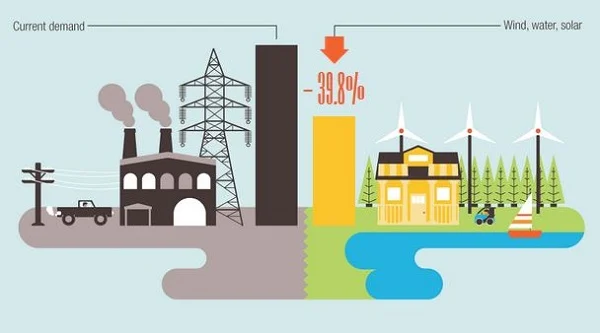Mark Jacobson, the Stanford professor who specializes in designing scenarios for a massive transition to renewable energy, is at it again – in a more high-profile way than ever.
After coming up with detailed proposals for how a few states could get to 100 percent renewables in the first half of the century, Jacobson is now promoting “The Solutions Project,” which includes an interactive website that points the way to an all-wind, water and sunlight 2050 for each and every state in the union.
Check it out and see what your state might do. For my home state of Oregon, a click on the map reveals a 2050 energy mix led by 30 percent onshore wind, 25 percent hydroelectric, 15 percent offshore wind and 10 percent solar PV plants. In the rather more sunny state of Arizona, the mix leads with 30 percent each of solar PV plants and concentrating solar power, with 20.5 percent also coming from onshore wind.

Part of the infographic on the Oregon transformation (image via The Solutions Project)
The Solutions Project website also reveals information on land use, mortality, costs and more for each state.
It’s a totally cool tool – but is it totally unrealistic, too? Well, Jacobson’s plans are, indeed, inevitably mocked as unrealistic, but in the face of criticism he plunges forward in the belief that his work is scientifically valid and that a total transformation is necessary and would yield benefits that nay-saying numbers crunchers either can’t or refuse to see.
Last year, Carnegie Mellon’s Nathaniel Gilbraith and co-authors wrote that Jacobson’s plan to get New York to a 100 percent “wind, water and sunlight” (WWS) energy infrastructure ”substantially underestimates the costs and consequences of a transition to solely wind, water, and solar power by 2030 and in doing so provides a misleading assessment that is counterproductive for guiding sound, rational energy policy” [PDF].
Jacobson came back with a point-by-point rebuttal [PDF], but perhaps more interesting was how he went on the offensive, railing at Gilbraith’s endorsement of natural gas, a fuel that Jacobson derides as not simply a greenhouse-gas villain, but as a source of air pollution that has direct and dramatic ill health effects.
While that was a fight that went on in academic journals, the Solutions Project promises more visibility, as Jacobson has teamed with the likes of actor Mark Ruffalo and director Josh Fox. Hollywood-loathing conservatives will no doubt heap scorn, but the evangelistic Jacobson doesn’t sound worried.
“Global warming, air pollution and energy insecurity are three of the most significant problems facing the world today,” Jacobson, a senior fellow at the Stanford Woods Institute for the Environment and Precourt Institute for Energy, said in a statement. “Unfortunately, scientific results are often glossed over. The Solutions Project was born with the vision of combining science with business, policy, and public outreach through social media and cultural leaders – often artists and entertainers who can get the information out – to study and simultaneously address these global challenges.”






